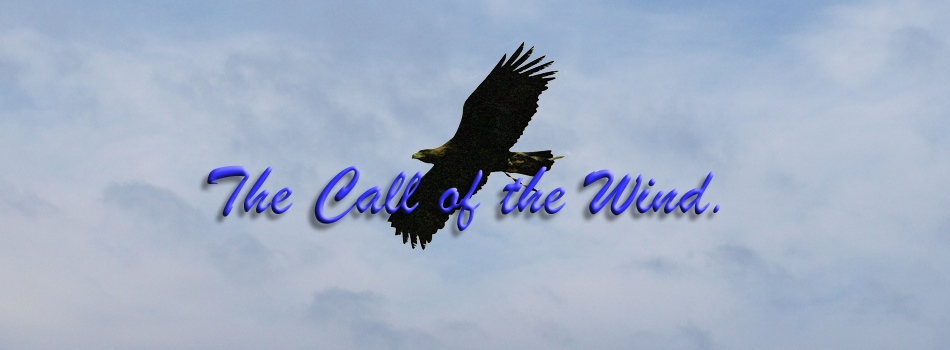"What on earth made you want to fly golden eagles?" ' I was once asked, by a smartly dressed falconer with a dainty peregrine tiercel stood on his fist. The answer is not as easy as one would imagine, and somewhat impossible to sum up in a few words. Looked at logically, there are possibly a lot more minuses to flying an eagle than there are pluses, but then attraction is rarely based on sensible reasoning.
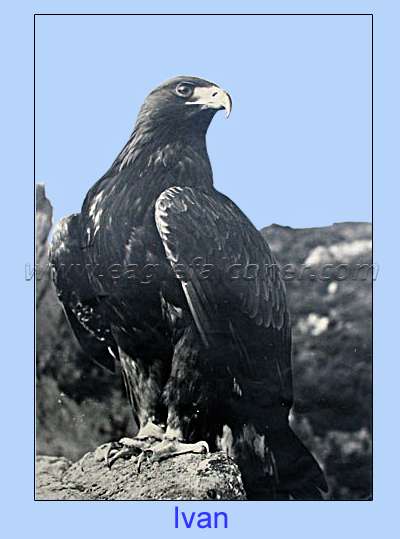 It was twenty five years ago when I was given my first opportunity to fly a golden eagle. A regal adult male, with a gentle temperament. We flew him at hare on the South Downs, and although I thoroughly enjoyed a few days sport in the company of this fine bird, the attraction of flying an eagle had not got a hold. Or at least, I was not aware that it had. It was twenty five years ago when I was given my first opportunity to fly a golden eagle. A regal adult male, with a gentle temperament. We flew him at hare on the South Downs, and although I thoroughly enjoyed a few days sport in the company of this fine bird, the attraction of flying an eagle had not got a hold. Or at least, I was not aware that it had.
In those days of the mid sixties, only a few falconers owned golden eagles. There were less then nine eagles wearing jesses in the British Isles, and only three or four of those regularly flown at quarry.
The few who had attempted to train a golden eagle to hunt, accounted for may of the legendary stories of bad tempered eagles attacking their owners or spectators in the field. in general most of the experienced falconers of the day who put pen to paper to extol the art of falconry in book form, would, upon listing the various species of birds of prey suitable for the hunt, usually leave the eagle until last Then recount a catalogue of disaster that befell some poor unfortunate who had been foolish enough to attempt to train this most unpredictable and ferocious of birds. These stories usually ended with the poor owner at his wits end, giving the eagle to a zoo or menagerie. The writer who had probably never encountered an eagle, warning the reader never to be tempted for what ever reason. I had grown up with this advice ringing my ears, many good falconers had had eagles, but had soon given up with them. Unpredictable, with a slow, sluggish and boring performance was usually their verdict.
After twenty one consecutive seasons flying solely golden eagles, it is only now that I feel able to criticise those eagle falconers of the past Their greatest error was to consider an eagle as just a large version of a goshawk, instead one should look at how these birds hunt in the wild, adapt their training and hunting methods, and above all respect their greater intelligence. My decision to own and fly a golden eagle was all due to a short telephone conversation, when I was offered the fine male eagle, which I had flown on the Downs a few years previously. I was so taken aback and felt a little honoured a this offer, that I accepted without a great deal of thought But then I was young and impetuous,
At the time I lived in the Channel Islands, which am situated in the English Channel, just off the coast of Northern France. Not the most suitable place to hunt with a golden eagle, and quite a different terrain from the rolling hills of the South Downs.
After many hours of acclimatising myself to handling my new eagle 'lvan'. I was ready to start to hunt, and it was on the western coast of my native island of Jersey that I chose to start.
Here was probably the largest open space on the island. Something like four square miles of sand dunes, with a reasonable population of rabbits in residence.
Our early outings were a little intense, I was often worried that Ivan might take it into his head, for what ever reason, and fly out to sea. A prospect that filled me with dread, as I would be unable to follow, just stand and watch. As my confidence grew and his flying abilities developed I watched in 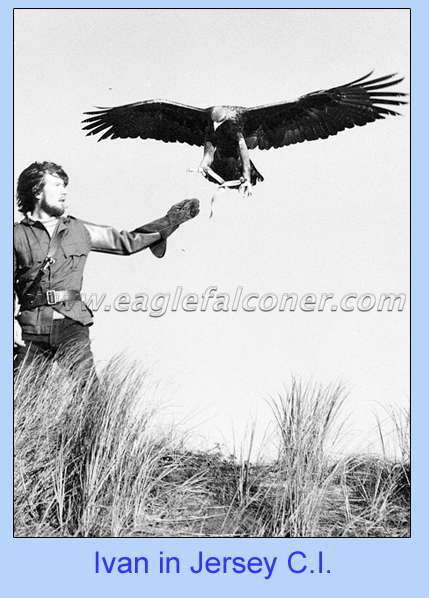 admiration as he rode out the sea born up-drafts. admiration as he rode out the sea born up-drafts.
Now I was experiencing or the first time what was to attract me to flying eagles for many years to come.
After a couple of seasons a natural Mm developed between myself and Ivan. I became a lot more confident as we both learnt to hunt the available ground that was suitable for an eagle. This in the main was the headland slopes above the islands sea cliffs. The northern and western coasts of Jersey. and the eastern and northern coasts of the tiny island of Herm were our favourite haunts. These headlands were steep, bracken and bramble covered slopes about two hundred yards wide and a few miles long. The main quarry here was the rabbit With almost total cover they were a wily adversary.
Ivan adapted a technique which was both exciting and successful. Using the natural up-draft from the cliffs he would ride backwards and forwards, as I struggled through the bracken beating the most likely looking hiding places. If anything moved, near me or ahead he would sail across and above the spot, roll over, close his wings and stoop, punching his way through the dense cover to grab a rabbit
He would often miss, as he would only get a glimpse of a rabbit as it sped its way through a network of tunnels, trampled by tiny feet under this vast blanket of bracken and brambles.
If there was a strong wind blowing, I would check on the direction,as it would determine as to which coast we would head for. I would fly Ivan in winds up to, and sometimes in gale force. In these conditions I defy anyone to stand, or try to stand with me, and say that a trained eagle is a boring performer. Here on the top of our sea born cliffs the wind has powered its way right across the Atlantic, with nothing in its path to dissipate its strength. Finally its smashes into the base of the islands granite cliffs, its full force now directed in an upward thrust I found it difficult to stand, and had to lean into the wind, in these conditions extra care must be taken not to go too close to the cliff edge.
Ivan with only his wing buts projecting, would power across the sky like a righter jet. He would dip low over the tops of the dead bracken and pass me at high speed, above the noise of the wind, I could hear a high pitch whine. At this speed his single leg bell would act as a very efficient whistle. He would turn towards the cliff edge and hit the full blast of the up-draft, within a second he rose at least two hundred feet vertical.
Now he would ride back over where I was beating, in these winds he can manage two speeds, Dead stop, as he hangs over a place where he last saw a rabbit, and with a slight tilt of his tail, full speed across the wind.
On days like this it is so easy to become a spectator, just to standard watch as he plays with the might of the wind. As he hangs high in the sky, gulls mill around scornful of this dangerous looking intruder. Sometimes a pair of Great Black Backed Gulls would escort him, one either side. At first Ivan would take no notice, to the gulls this is a sign of weakness. One would slip behind him to try and tweak his tail. As I watched I could see Ivan's head turn, instantly he would let the wind lift him up and then push him back over the gull. Now he was in a position to dive on this cheeky varmint and chase him a mile or so up the coast.
1 would watch him speed off into the distance, with the gull desperately trying to outmanoeuvre this now very determined pursuer. Soon Ivan would come back, hanging in the sky over my head, a rabbit moves and he crashes into the bracken. If he was successful he is rewarded and the rabbit goes into the bag. If not he would peer in disbelief all around, sometimes poking his head through the bracken and trying to look along the runs. Then when he was finally convinced that the bunny had shown him a clean pair of heals, he would half open his wings and the wind would
lift him from the spot to about one hundred feel. Thankfully we rarely caught more than three or four rabbits in a days outing. The weight in the hawking bag on the long walk home, might have balanced out the weight of the eagle, but neither did much for my tired old legs.
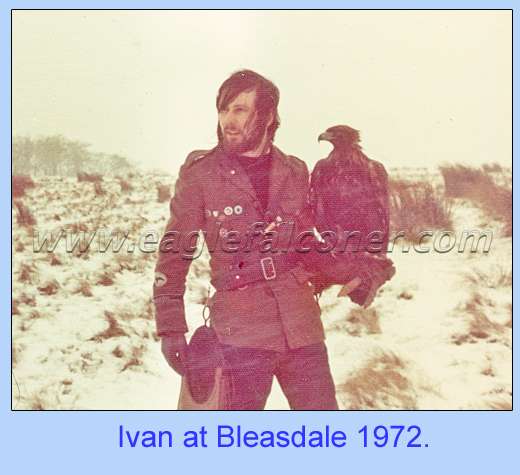 When I moved to mainland Britain, Ivan showed me he had not gone soft with rabbits, and took the large brown hares in fine style. The huge arable fields of Yorkshire and Lancashire gave many happy hare hawking outings. In the embryonic days of the Falconers Association (Hunting Group) in the early seventies, quite large meetings of falconer's and their hawks would gather on the Bleasdale estate in Lancashire. Here we had permission for some 10,000 acres over which to fly our birds. Unfortunately the weather was not always kind to us. High winds, and, on occasion blizzard snow soon grounded the goshawks. Not Ivan, he was up, with about thirty beaters below all trying to serve him. Two or three hares could be on the run at once. He would swoop down on the nearest and if it slipped out of his clutch, he would rise up and swoop after another. When I moved to mainland Britain, Ivan showed me he had not gone soft with rabbits, and took the large brown hares in fine style. The huge arable fields of Yorkshire and Lancashire gave many happy hare hawking outings. In the embryonic days of the Falconers Association (Hunting Group) in the early seventies, quite large meetings of falconer's and their hawks would gather on the Bleasdale estate in Lancashire. Here we had permission for some 10,000 acres over which to fly our birds. Unfortunately the weather was not always kind to us. High winds, and, on occasion blizzard snow soon grounded the goshawks. Not Ivan, he was up, with about thirty beaters below all trying to serve him. Two or three hares could be on the run at once. He would swoop down on the nearest and if it slipped out of his clutch, he would rise up and swoop after another.
These displays of hare hawking certainly encouraged a few falconers of that time to consider the eagle, and with the possibility of obtaining licenses to lake golden eaglets from their highland eyrie's, it made what had once been an impossible dream, a bit more of a reality.
June 1973 found me, in the Grampian Mountains in the Highlands of Scotland, I had just lowered a cane basket down the steep crag, inside was Maria a down covered female eaglet. Sat behind me in the eyrie was her brother, I had just hand fe d him a few slivers of grouse meat before l too lowered myself off the ledge and out of his life.
Maria was about three weeks younger than I had hoped for, but she already weighed eight and a 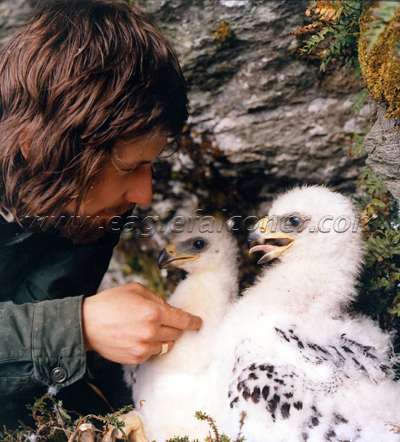 quarter pounds and my time in the highlands was running out. She was the first female eaglet taken under licence, and at the time there was only one other trained female eagle being flown in Britain. quarter pounds and my time in the highlands was running out. She was the first female eaglet taken under licence, and at the time there was only one other trained female eagle being flown in Britain.
I was subjected to the same negative reaction from fellow falconers, that I had had when first embarking on eagle flying. Golden eagles in general still carried a bad press, and anyone attempting to train a female really had lost his marbles. After all Capt. C.W.R. Knight attempted to train two females, and returned both of them from whence they came. One, very nearly caused the loss of one eye when she too hold of the side of his face. Both these females started to develop a seriously bad habit of grabbing at his free hand whilst standing on the gloved arm.
Maria grew up in an open straw lined pen of the farm, she was given unlimited food and just left to bask in the sun and grow. This she did and was soon a magnificent dark uniform brown, with a golden head and superb white banded tail. The most striking feature (no pun intended) was the large span of her feet, each foot had an equal span to my hand and was fearsomely armed.
The early stages of training Maria were very straight forward, I encouraged her with great care to return to the fist, or should I say arm. The ultimate rule in this practise, is never take away any of the reward held in your fist. Always allow the eagle to at all that you offered her, if you fail to follow this basic rule you will encourage her to guard her food, gripping your gloved hand with crippling power and lashing out to grab your bare hand as you attempt to make away with her prize.
What takes most novice eagle falconers by surprise, is the speed in which an eagle will suss out your mistakes in training her. Sloppy moves in which you might trick a goshawk and the like, an eagle will notice, assess and take advantage of by the third time you try it on.
I flew Maria to the fist for about a year, one soon learns to compensate for the moment of contact as she lands. The only reason I stopped was attributed to inexperience on both our pans. It was at the end of an afternoon hare hawking over some winter wheat fields, a stiff wind was developing and dusk was falling. Time to call it a day, Mafia was sitting in the middle of a large oak tree in the hedgerow, from where she had commanded an excellent view as I walked the
field towards her. I held up my arm as I walked away from her, and as usual she left her position to return to me. The direction of her approach gave her a tail wind and the visibility was dropping , I heard her approach and felt her land, one foot on my arm and the other on the back of my head. I bent forward and she continued onto the ground in front of me, luckily she had not gripped and I had no marks, but I can still feel that foot clasping the back of my head today. I took it as a sort of warning, and now she returns to a reward on the ground.
She was soon riding the updrafts from the moorland valleys, here in the high hills Maria pursues the hill fox and the occasional roe. With her much greater weight than the male eagle, she packs an almighty punch from a high stoop. She has killed both these species of quarry stone dead with one stoop, the largest to go this way was a roe at fifty two pounds in weight
Once again here was proof against those disparaging remarks of a female golden eagles performance. 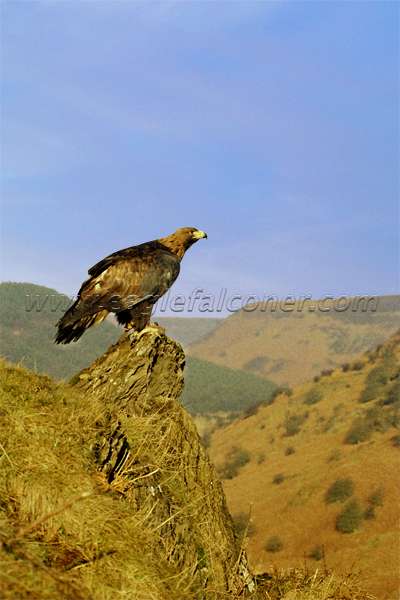 Maria developed a devil may care attitude to flying Maria developed a devil may care attitude to flying
in wild weather, similar to horses it seemed to excite her as she tore across the sky on half open wings.
We would often hunt over hillsides covered with small sized oak plantations, and Maria has often pursued above the trees, ground game running along the woodland floor. She obviously calculates where there is the least obstructions ø and dives through the branches. I make this statement because she is never hurt or deflected off her aim, but the resounding crash and the number of small branches she breaks as she punches her way through the trees , often makes me flinch as I despair at her disregard for her own safety. With suitable quarry quite scarce on the moorland hills, she will regularly play on the wind. Letting it take her higher, then swooping earthwards she levels out, streaking along the flat moorland tops, passing me at shoulder level she cocks an eye to me, then out over-the edge and bang straight into the updraft and vertically up for a couple of hundred feet
This is what attracts me to flying golden eagles, as I walk the hills she defies the elements to throw all they have at her, and she rides it like a roller coaster. We do not need any quarry to see a spectacular display,evolution has honed this bird to aerial perfection all that is required is the wind and real eagle country in which to fly her.
|
